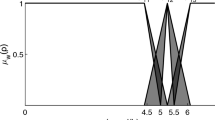Abstract
The accurate interpretation of Blood Glucose (BG) values is essential for diabetes care. However, BG monitoring data does not provide complete information about associated meal and moment of measurement, unless patients fulfil it manually. An automatic classification of incomplete BG data helps to a more accurate interpretation, contributing to Knowledge Management (KM) tools that support decision-making in a telemedicine system. This work presents a fuzzy rule-based classifier integrated in a KM agent of the DIABTel telemedicine architecture, to automatically classify BG measurements into meal intervals and moments of measurement. Fuzzy Logic (FL) tackles with the incompleteness of BG measurements and provides a semantic expressivity quite close to natural language used by physicians, what makes easier the system output interpretation. The best mealtime classifier provides an accuracy of 77.26% and does not increase significantly the KM analysis times. Results of classification are used to extract anomalous trends in the patient’s data.
Access this chapter
Tax calculation will be finalised at checkout
Purchases are for personal use only
Preview
Unable to display preview. Download preview PDF.
Similar content being viewed by others
References
The Diabetes Control and Complications Research Group: The effect of intensive treatment of diabetes on the development and progression of long-term complications in insulin-dependent diabetes mellitus. New England Journal of Medicine 329, 977–986 (1993)
International Diabetes Federation (IDF): Clinical guidelines task force, global guideline for type 2 diabetes, 2005. Technical report, TR (2005)
Benjamin, E.M.: Self-monitoring of blood glucose: The basics. Clin Diabetes 20(1), 45–47 (2002)
Shea, S., Weinstock, R.S., Starren, J., et al., for the IDEATel Consortium: A randomized trial comparing telemedicine case management with usual care in older, ethnically diverse, medically underserved patients with diabetes mellitus. Journal of the American Medical Informatics Association 13(1), 40–51 (2006)
Rigla, M., Hernando, M.E., Gómez, E.J., Brugués, E., García-Sáez, G., Capel, I., Pons, B., de Leiva, A.: Real-time continuous glucose monitoring together with telemedical assistance improves glycemic control and glucose stability in pump-treated patients. Diabetes Technology & Therapeutics 10(3), 194–199 (2008)
Bellazzi, R., Arcelloni, M., Ferrari, P., Decata, P., Hernando, M.E., García, A., Gazzaruso, C., Gómez, E.J., Larizza, C., Fratino, P., Stefanelli, M.: Management of patients with diabetes through information technology: Tools for monitoring and control of the patients’ metabolic behavior. Diabetes Technology & Therapeutics 6(5), 567–578 (2004)
Dinesen, B., Andersen, P.E.R.: Qualitative evaluation of a diabetes advisory system, diasnet. Journal of Telemedicine and Telecare 12(2), 71–74 (2006)
Zadeh, L.A.: The concept of a linguistic variable and its application to approximate reasoning. Parts I, II, and III. Information Sciences 8, 8, 9, 199–249, 301–357, 43–80 (1975)
Mamdani, E.H.: Application of fuzzy logic to approximate reasoning using linguistic systems. IEEE Transactions on Computers 26(12), 1182–1191 (1977)
Gómez, E.J., Hernando, M.E., Vering, T., Rigla, M., Bott, O., García-Sáez, G., Pretschner, P., et al.: The inca system: A further step towards a telemedical artificial pancreas. IEEE Transactions on Information Technology in Biomedicine 12(4), 470–479 (2008)
García-Sáez, G., Hernando, M.E., Martínez-Sarriegui, I., Rigla, M., Torralba, V., Brugués, E., de Leiva, A., Gómez, E.J.: Architecture of a wireless personal assistant for telemedical diabetes care. International Journal of Medical Informatics 78(6), 391–403 (2009)
Alonso, J.M., Guillaume, S., Magdalena, L.: KBCT: A knowledge management tool for fuzzy inference systems. Free software under GPL license (2003), http://www.mat.upm.es/projects/advocate/kbct.htm
Alonso, J.M., Magdalena, L., Guillaume, S.: HILK: A new methodology for designing highly interpretable linguistic knowledge bases using the fuzzy logic formalism. International Journal of Intelligent Systems 23, 761–794 (2008)
Ichihashi, H., et al.: Neuro-fuzzy ID3: A method of inducing fuzzy decision trees with linear programming for maximizing entropy and an algebraic method for incremental learning. Fuzzy Sets and Systems 81, 157–167 (1996)
Quinlan, J.R.: Induction of decision trees. Machine Learning 1, 81–106 (1986)
Plutowski, M., Sakata, S., White, H.: Cross-validation estimates imse. In: Cowan, J.D., Tesauro, G., Alspector, J. (eds.) Advances in Neural Information Processing Systems 6, pp. 391–398. Morgan Kaufmann, San Mateo (1994)
Author information
Authors and Affiliations
Editor information
Editors and Affiliations
Rights and permissions
Copyright information
© 2009 Springer-Verlag Berlin Heidelberg
About this paper
Cite this paper
García-Sáez, G. et al. (2009). Mealtime Blood Glucose Classifier Based on Fuzzy Logic for the DIABTel Telemedicine System. In: Combi, C., Shahar, Y., Abu-Hanna, A. (eds) Artificial Intelligence in Medicine. AIME 2009. Lecture Notes in Computer Science(), vol 5651. Springer, Berlin, Heidelberg. https://doi.org/10.1007/978-3-642-02976-9_42
Download citation
DOI: https://doi.org/10.1007/978-3-642-02976-9_42
Publisher Name: Springer, Berlin, Heidelberg
Print ISBN: 978-3-642-02975-2
Online ISBN: 978-3-642-02976-9
eBook Packages: Computer ScienceComputer Science (R0)




